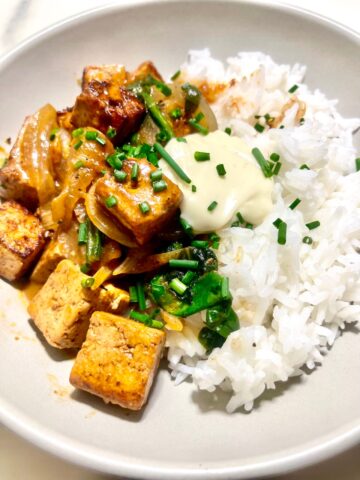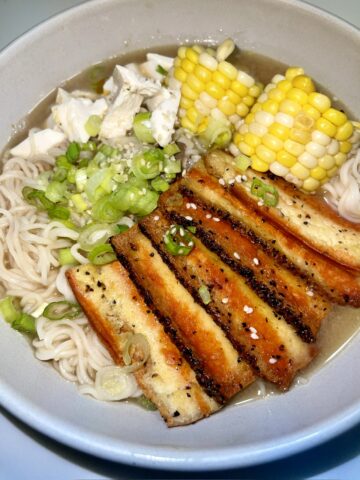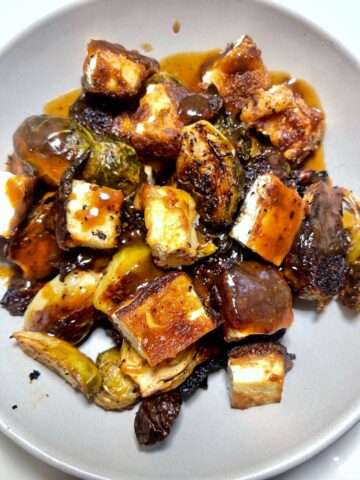We made some meaty vegan balls made of Lentils on spaghetti noodles & walnut pesto.

What are lentils and how to cook them
Lentils are small, lens-shaped legumes that come in various colors, including green, brown, red, and black. They are a staple in many cuisines around the world and are known for their versatility and nutritional value. In this essay, we will explore what lentils are and provide some tips on how to cook them.
Lentils are a type of pulse, which refers to the dried seeds of legumes. They are a rich source of plant-based protein, fiber, vitamins, and minerals. Lentils are also low in fat and cholesterol-free, making them a healthy addition to any diet.
To cook lentils, follow these simple steps:
- Rinse and Sort: Before cooking lentils, rinse them thoroughly under cold water to remove any dirt or debris. Additionally, sort through the lentils to remove any stones or damaged lentils that may be present.
- Choose the Right Cooking Method: There are several ways to cook lentils, including boiling, simmering, or using a pressure cooker. The cooking time will vary depending on the type of lentils and the desired texture. Generally, green and brown lentils take around 20-30 minutes to cook, while red and yellow lentils cook faster, usually within 15-20 minutes.
- Add Liquid: Place the rinsed lentils in a pot or saucepan and add enough liquid to cover them. The ratio of liquid to lentils is typically 2:1, meaning two cups of liquid for every cup of lentils. You can use water, vegetable broth, or any other flavorful liquid of your choice.
- Seasoning: Lentils have a mild flavor, making them a great canvas for various seasonings and spices. Add salt, pepper, herbs, or spices like cumin, turmeric, or paprika to enhance the taste. You can also add chopped onions, garlic, or vegetables for added flavor and nutrition.
- Cooking Time: Bring the liquid to a boil, then reduce the heat to a simmer. Cover the pot and let the lentils cook until they reach the desired tenderness. Stir occasionally to prevent sticking. Check the lentils for doneness by tasting them. They should be tender but still hold their shape.
- Enjoy: Once the lentils are cooked, drain any excess liquid if necessary. Lentils can be enjoyed on their own as a side dish, added to soups, stews, salads, or used as a filling for wraps and sandwiches. They can also be mashed and used as a base for vegetarian burgers or meatballs.
lentils are a versatile and nutritious legume that can be cooked in various ways. They are a great source of protein, fiber, and other essential nutrients. By following these simple steps, you can easily cook lentils and incorporate them into your meals for a healthy and delicious addition to your diet.
Vegan Lentil Balls
Boil lentils along with other vegetables you might have in the fridge. Get creative here and feel free to clean up the fridge of the vegetables you might want to get rid of.
Achieve a ground meat type of texture and season it up with oil, maybe some bbq seasoning, Worcestershire and pink Himalayan salt. You may add a binder of chips, crackers or flour.
Ball them up and sear in a cast iron pan. You may finish the cooking in an oven too!
Vegan Balls Variations
Vegan balls, also known as plant-based meatballs, are a versatile and delicious alternative to traditional meatballs. They can be made using a variety of ingredients and flavors, allowing for endless possibilities. In this essay, we will explore some popular variations of vegan balls that cater to different tastes and dietary preferences.
- Lentil and Mushroom Balls:
Lentils and mushrooms are a winning combination when it comes to vegan balls. Cooked lentils provide a hearty texture, while mushrooms add a savory and umami flavor. Combine cooked lentils, sautéed mushrooms, breadcrumbs, onions, garlic, and your choice of herbs and spices. Form the mixture into balls and bake or pan-fry until golden brown. These lentil and mushroom balls are packed with protein, fiber, and a rich, earthy taste. - Chickpea and Spinach Balls:
Chickpeas, also known as garbanzo beans, are a popular ingredient in vegan cooking due to their versatility and nutritional value. Combine mashed chickpeas, cooked spinach, breadcrumbs, onions, garlic, and spices like cumin and paprika. Shape the mixture into balls and bake or pan-fry until crispy. These chickpea and spinach balls are packed with protein, iron, and vitamins, and offer a delightful combination of flavors. - Quinoa and Black Bean Balls:
Quinoa and black beans make a protein-packed duo that is perfect for vegan balls. Cooked quinoa provides a fluffy texture, while black beans add a creamy and hearty element. Combine cooked quinoa, mashed black beans, breadcrumbs, onions, garlic, and your choice of herbs and spices. Shape the mixture into balls and bake or pan-fry until golden and crispy. These quinoa and black bean balls are not only delicious but also rich in fiber, antioxidants, and essential nutrients. - Walnut and Sun-Dried Tomato Balls:
For a unique and flavorful twist, try making vegan balls using walnuts and sun-dried tomatoes. Walnuts provide a meaty texture and a rich source of healthy fats, while sun-dried tomatoes add a tangy and sweet flavor. Blend walnuts, sun-dried tomatoes, breadcrumbs, onions, garlic, and herbs like basil and oregano in a food processor until well combined. Shape the mixture into balls and bake or pan-fry until crispy. These walnut and sun-dried tomato balls offer a burst of flavor and are a great source of omega-3 fatty acids. - Tofu and Vegetable Balls:
Tofu is a versatile ingredient that can be used to create delicious vegan balls. Combine crumbled tofu, finely chopped vegetables like carrots, bell peppers, and zucchini, breadcrumbs, onions, garlic, and your choice of herbs and spices. Shape the mixture into balls and bake or pan-fry until golden and firm. These tofu and vegetable balls are packed with protein, vitamins, and minerals, and can be enjoyed in various dishes like pasta, stir-fries, or as a standalone appetizer.
Vegan balls offer a wide range of variations to suit different tastes and dietary preferences. Whether you prefer lentils and mushrooms, chickpeas and spinach, quinoa and black beans, walnut and sun-dried tomatoes, or tofu and vegetables, there is a vegan ball recipe for everyone. These plant-based alternatives are not only delicious but also packed with nutrients, making them a great addition to any vegan or vegetarian diet. So, get creative in the kitchen and enjoy the endless possibilities of vegan balls.
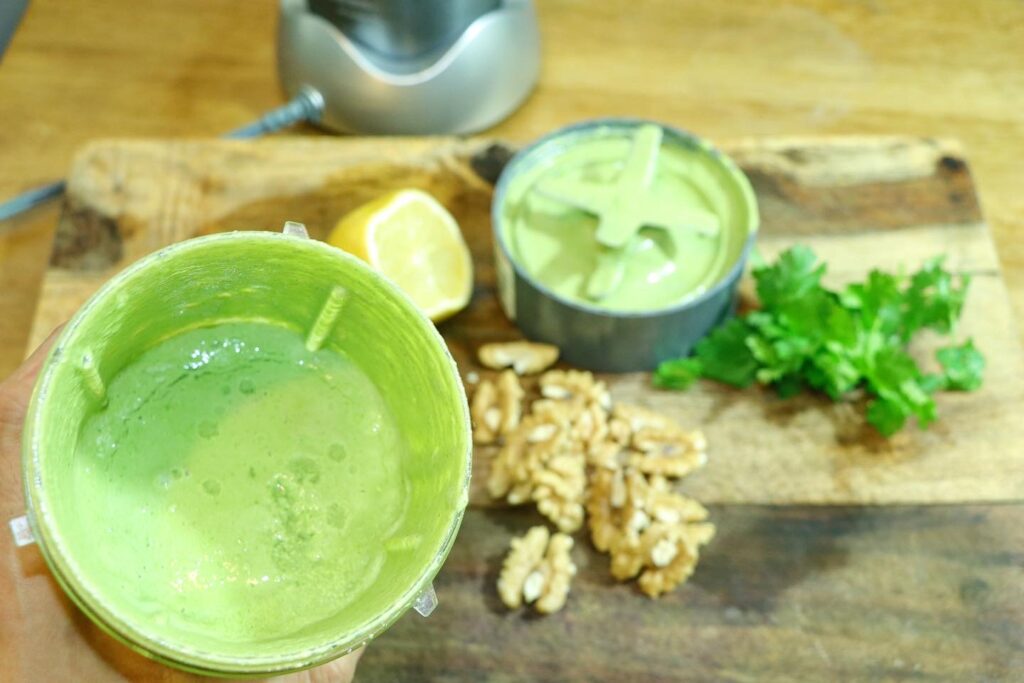
Walnut Pesto
Parsley, basil or cilantro, they all work. Add some walnuts, water & oil, maybe some nutritional yeast and lemons. Use your intuitive skills on achieving he perfect texture and taste. Feel free to make variations.
Vegan Pesto Variations
Vegan pesto is a flavorful and versatile sauce that can be used in a variety of dishes. Traditionally, pesto is made with basil, pine nuts, Parmesan cheese, garlic, and olive oil. However, there are numerous variations of vegan pesto that cater to different dietary preferences and allergies. In this essay, we will explore some popular vegan pesto variations that are equally delicious and easy to make.
- Classic Basil and Cashew Pesto:
To make a vegan version of the classic basil pesto, simply replace the Parmesan cheese with nutritional yeast or vegan Parmesan cheese. Blend fresh basil leaves, cashews, nutritional yeast, garlic, lemon juice, and olive oil in a food processor until smooth. Season with salt and pepper to taste. This vegan basil and cashew pesto is creamy, aromatic, and perfect for pasta, sandwiches, or as a dip. - Sun-Dried Tomato and Almond Pesto:
For a tangy and rich flavor, try making a vegan pesto using sun-dried tomatoes and almonds. Blend sun-dried tomatoes (either dry or packed in oil), almonds, garlic, basil leaves, lemon juice, and olive oil in a food processor until well combined. Adjust the consistency by adding more olive oil if desired. This sun-dried tomato and almond pesto is packed with umami flavors and can be used as a spread, sauce, or dip. - Spinach and Walnut Pesto:
If you're looking to add some greens to your pesto, try making a vegan version using spinach and walnuts. Blend fresh spinach leaves, walnuts, garlic, nutritional yeast, lemon juice, and olive oil in a food processor until smooth. Season with salt and pepper to taste. This spinach and walnut pesto is vibrant, nutritious, and can be used in pasta dishes, salads, or as a spread on sandwiches. - Kale and Pistachio Pesto:
For a unique twist on vegan pesto, use kale and pistachios as the main ingredients. Blend fresh kale leaves, pistachios, garlic, nutritional yeast, lemon juice, and olive oil in a food processor until well combined. Adjust the consistency by adding more olive oil if needed. This kale and pistachio pesto is packed with nutrients, has a vibrant green color, and can be used in pasta, grain bowls, or as a dip for vegetables. - Cilantro and Pumpkin Seed Pesto:
For a fresh and herbaceous flavor, try making a vegan pesto using cilantro and pumpkin seeds. Blend fresh cilantro leaves, pumpkin seeds, garlic, lime juice, olive oil, and a pinch of cumin in a food processor until smooth. Season with salt and pepper to taste. This cilantro and pumpkin seed pesto is bright, zesty, and pairs well with Mexican or Tex-Mex inspired dishes.
Vegan pesto offers a wide range of variations that cater to different tastes and dietary preferences. Whether you prefer the classic basil and cashew pesto, sun-dried tomato and almond pesto, spinach and walnut pesto, kale and pistachio pesto, or cilantro and pumpkin seed pesto, there is a vegan version for everyone. These pesto variations are packed with flavor, nutrients, and can be used in a variety of dishes to add a burst of freshness and vibrancy. So, get creative in the kitchen and enjoy the endless possibilities of vegan pesto.
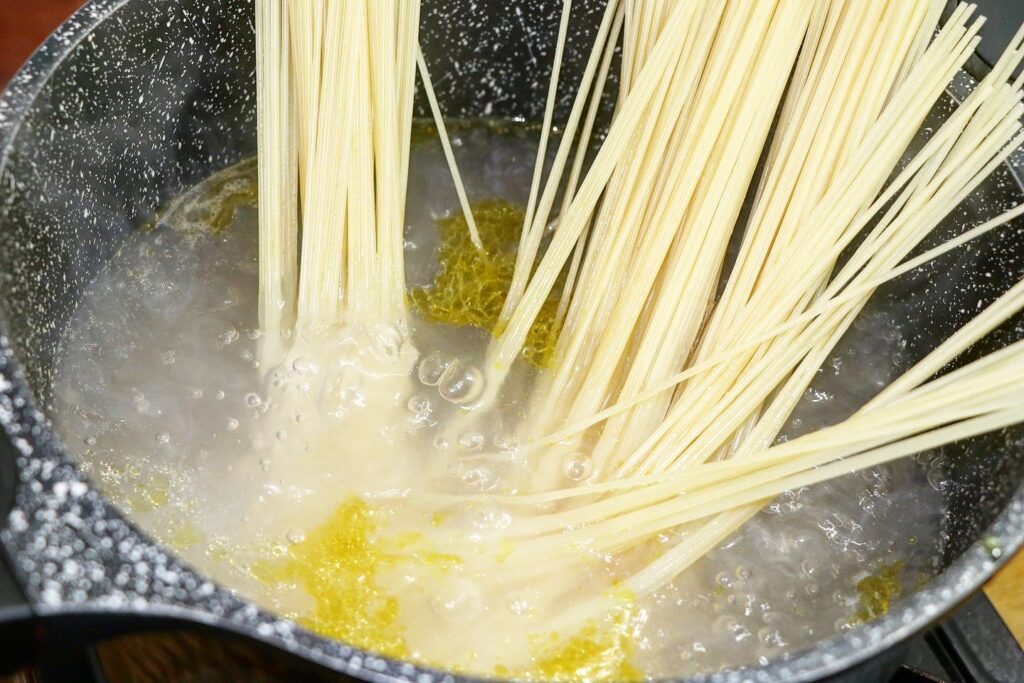
Spaghetti Noodles
Cook spaghetti noodles for 9 minutes in a pot of salted boiling water. Strain and run through cold water and toss in oil.
Assemble Noodles, Pesto & Vegan meatballs! Enjoy this framework and share with people you love!
Cilantro pesto & Lentil Balls
Ingredients
- 1 Cup lentils
- 1 Bulb onion
- 5 tablespoon olive oil
- 3 tablespoon flour
- 2 tablespoon seasoning of choice
- 1 Cup walnuts
- 1 Bunch cilantro
- 1 Piece lemons
- 400 grams spaghetti noodles
Instructions
- Cook spaghetti noodles as directed in the package. Strain and toss in oil and salt.
- Saite onions or whatever veggies you might have on hand. Add lentils and liquid. Cook until the lentils appear to have a pasty texture. Add flour if preferred. Make sure you season your patty with wostershire, soy or how ever you want it seasoned. Get creative.
- Form into balls, sear in a hot pan and finish in the oven. An opportunity to brush up on your roasting skills.
- Make cilantro pesto by blitzing walnuts, water, oil, cilantro, garlic, salt and juice of a lemon. Adjust texture and flavor using your skills.
- Assemble noodles, sauce and balls together. Making sure each component is flavored and cooked properly. Enjoy!





